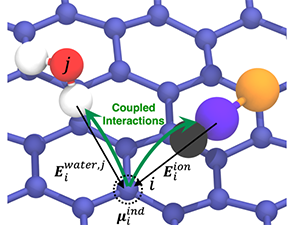Ion Adsorption at Solid/Water Interfaces: Establishing the Coupled Nature of Ion–Solid and Water–Solid Interactions
 J. Phys. Chem. C 2021, 125, 4, 2666–2679
J. Phys. Chem. C 2021, 125, 4, 2666–2679
Rahul Prasanna Misra and Daniel Blankschtein
The abstract reads as follows: Understanding the thermodynamics of ion adsorption at solid/water interfaces is essential for all energy- and membrane-based applications involving electrolytes. At any solid/water interface, the ion–solid and water–solid interactions are intrinsically coupled through the electric fields exerted by the salt ions and the water molecules, which polarize the solid surface, yet the implications of this coupling on the adsorption behavior of ions remain unknown. In this article, we develop a theoretical framework involving all-atomistic polarizable force fields and computationally investigate the adsorption of a thiocyanate (SCN–) ion at the graphene/water interface, including comparing with available experimental data. We show that, in vacuum, the electric field exerted by the SCN– ion strongly polarizes the carbon atoms in graphene, resulting in a significantly large graphene–ion polarization energy. However, at the graphene/water interface, the interactions of the electric field vectors exerted by the interfacial water molecules with those of the SCN– ion result in a 93% screening of the graphene–ion polarization energy, thereby significantly weakening the graphene–ion interactions. Further, the free energy of SCN– adsorption predicted by our theoretical framework agrees quantitatively with the experimental result, whereas we show that an implicit modeling of the graphene–ion polarization energy using a pairwise additive potential such as the Lennard-Jones potential results in a significant overprediction by more than 10 kcal/mol. Therefore, our study highlights the critical role played by the coupled nature of the ion–solid and water–solid interactions in governing the energetics of ion adsorption at solid/water interfaces.
R.P.M. and D.B. acknowledge the financial support received as part of the Center for Enhanced Nanofluidic Transport (CENT), an Energy Frontier Research Center funded by the U.S. Department of Energy, Office of Science, Basic Energy Sciences under award DE-SC0019112.
https://pubs.acs.org/doi/10.1021/acs.jpcc.0c09855
